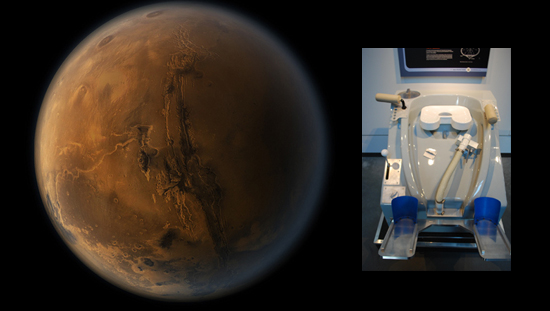Mars Astronauts to Protect Themselves From Radiation With Poo, Because Sure, Why Not
Even as the Curiosity rover roves across the rusty-hued surface of Mars collecting samples, multimillionaire “space tourist” Dennis Tito announced earlier this week that he plans to send his own mission to the Red Planet in five years. Except Tito’s intent on sending humans, not robots. That’s a formidable trip to make, fraught with the perils of time, atrophy, boredom, and high-energy radiation from the depths of space! To protect against such cosmic rays, Tito’s team says they will use the astronauts’s own fecal matter as part of their wall shielding.
Two leading things to keep in mind: (1) Cosmic rays, which come from deep space, are deadly and constant. Even if you shield against them, what remains can still be harmful, and (2) Tito’s mission isn’t meant to be an exploratory quest of flag-planting and rock-gathering on Mars, just a two-person fly-over inside a small, cramped vessel (which hasn’t been built yet). Even so, the dangers are real.
Not since Kevin Costner’s pee-drinking scene in Waterworld have we seen such a practical use of recycled waste. To be fair, they’re not suggesting that only poo be used, because gross. No, food and water would also be layered up on the walls of the ship to construct whatever shielding they can. It’s simply a pragmatic application of the law of the conservation of matter, because space aboard a vessel like the one they’re going to need is hard to come by, and you’ve got to hold onto and use everything you’ve got.
A member of Tito’s team, Taber MacCallum told the New Scientist:
It’s a little queasy sounding, but there’s no place for that material to go, and it makes great radiation shielding. …Dehydrate [it] as much as possible, because we need to get the water back. Those solid waste products get put into a bag, put right back against the wall.
This utilitarian — or poo-shielding — plan is part of the team’s Water Walls project, “which combines life-support and waste-processing systems with radiation shielding.” Initially the walls of the spacecraft would be lined with special, polyethylene bags filled with drinking water, because water molecules contain more nuclei per volume than metal, which in turn means more protection against the aforementioned cosmic rays. (Which, by the way, can seriously diminish your lifespan.) Gradually, as the water is drawn out for drinking, it’s replaced with waste.
Survival logistics aside, there’s still the matter of whether Dennis Tito’s ambitious, not-sanctified-by-NASA mission will get off the ground. There are plenty of skeptics and believers in the 72-year-old’s dream. Mars and Earth come into alignment once every 15 years, and Tito’s mission is calculated as taking 501 days, and is set to launch on January of 2018.
(New Scientist, images courtesy of J.Gabás Esteban and OnceAndFutureLaura)
- Watch SpaceX’s Dragon launch
- Curiosity Rover’s taste of Martian bedrock
- Scientists say Europa, not Mars, is the best place to search for life
Have a tip we should know? tips@themarysue.com
